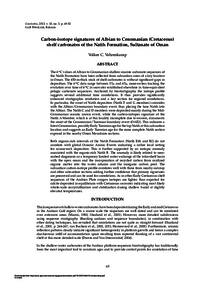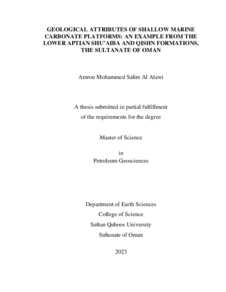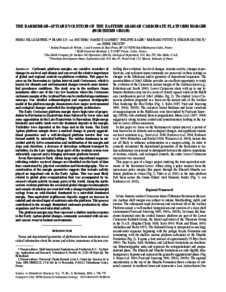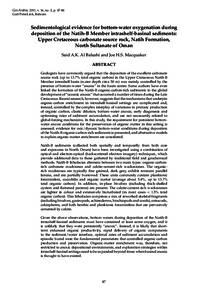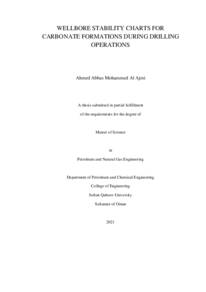Document
Carbon-isotope signatures of albian to cenomanian (cretaceous) shelf carbonates of the natih formation, Sultanate of Oman.
Identifier
DOI: 10.2113/geoarabia180365
Publisher
Gulf Petrolink.
Gregorian
2013-07
Language
English
Subject
English abstract
The δ13C values of Albian to Cenomanian shallow-marine carbonate sequences of the Natih Formation have been collected from subsurface cores of a key location in Oman. The 450-m-thick stack of shelf carbonates is without significant gaps in deposition. The δ13C data range between 1‰ and 6‰, more-or-less tracking the evolution over time of δ13C in seawater established elsewhere in time-equivalent pelagic carbonate sequences. Anchored by biostratigraphy the isotope profile suggests several additional time correlations. It thus provides significantly enhanced stratigraphic resolution and a key section for regional correlations. In particular, the onset of Natih deposition (Natih F and G members) coincides with the Albian/Cenomanian boundary event, thus placing the base Natih into the Albian. The Natih C and D members were deposited mainly during the Mid- Cenomanian oceanic anoxic event, while the carbon-isotopes signature of the Natih A Member, which is at this locality incomplete due to erosion, documents the onset of the Cenomanian/Turonian boundary event (OAE2). This indicates a latest Cenomanian, possibly Early Turonian age for the top Natih at this subsurface location and suggests an Early Turonian age for the more complete Natih section exposed in the nearby Oman Mountains sections. Both organic-rich intervals of the Natih Formation (Natih E4b and B2) do not correlate with global Oceanic Anoxic Events indicating a rather local setting for source-rock deposition. This is further supported by an isotopic anomaly associated with the organic-rich Natih B. The anomaly is likely related to nearseabed diagenesis or a temporary limited water exchange of the intra-shelf basin with the open ocean and the incorporation of recycled carbon from oxidized organic matter into the water column and the inorganic carbon pool. The subsurface carbon-isotope profile correlates well with those from nearby outcrop and other subsurface sections adding further confidence that primary signatures are preserved and can be used for correlations. As in other Early Cretaceous shelf sequences of the Arabian Plate oxygen isotopes are lighter than expected for calcite deposited in equilibrium with Cretaceous seawater indicating most likely whole-scale recrystallization and stabilization during shallow burial at slightly elevated temperatures.
Member of
ISSN
1025-6059
Resource URL
Category
Journal articles

